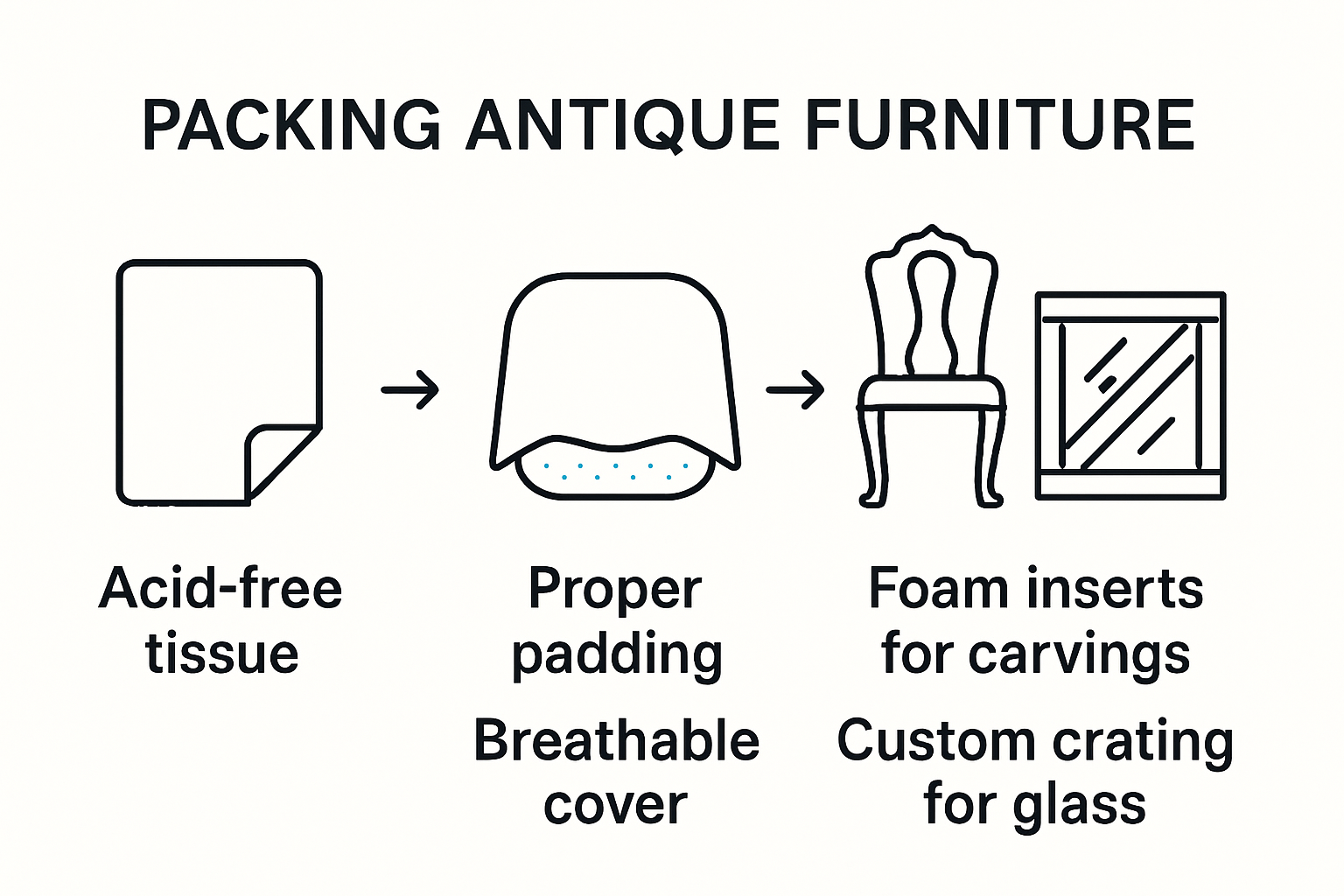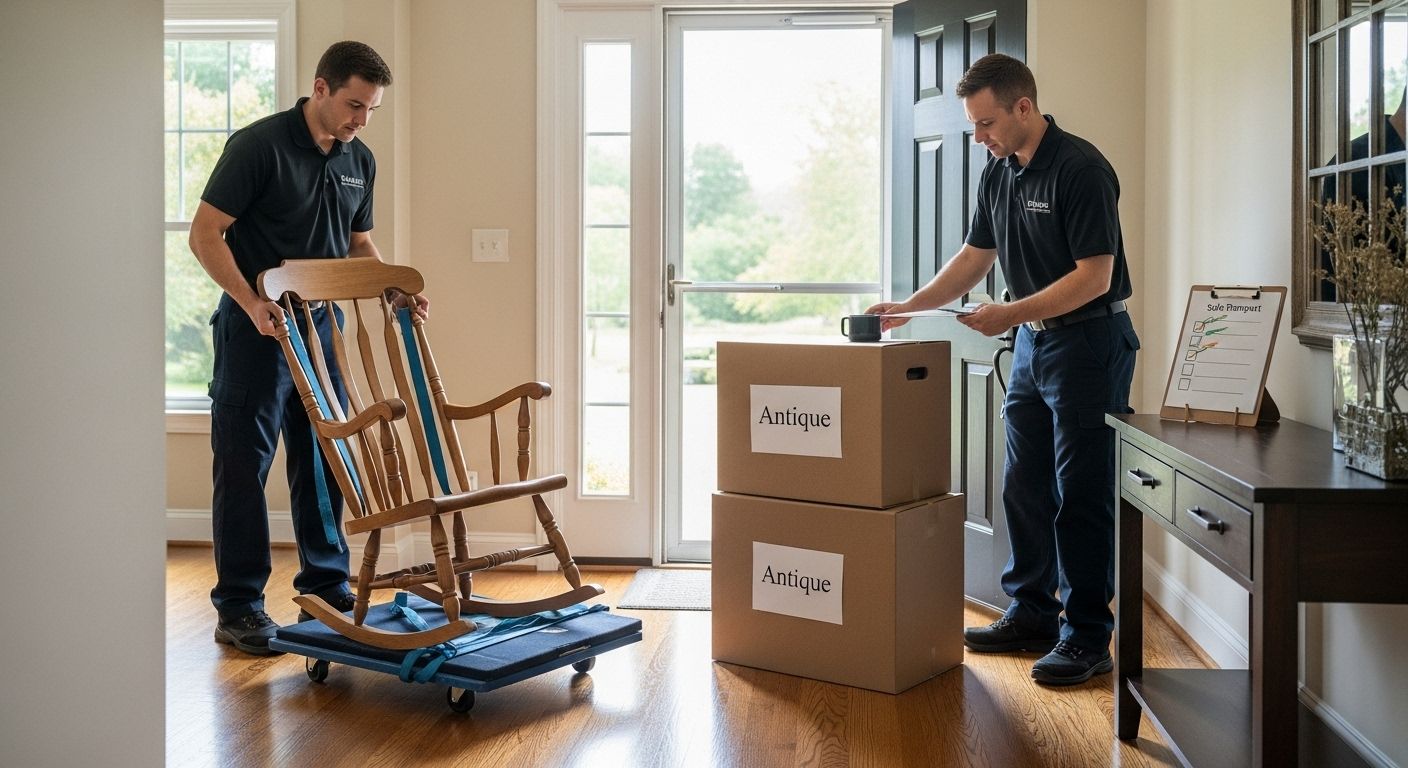Moving antique furniture takes more than muscle and packing tape. Shockingly, nearly one out of every five antique pieces sustain damage during standard moves. Most people assume a few blankets and bubble wrap are enough, but what really protects these century-old treasures is a whole different strategy. Discover why even seasoned movers can miss the key details that keep your heirlooms safe for generations.
Table of Contents
- Preparing Antique Furniture For Moving
- Choosing The Right Packing Materials
- Safe Transport And Handling Techniques
- What To Look For In Antique Moving Services
Quick Summary
| Takeaway | Explanation |
|---|---|
| Conduct a thorough pre-move inspection | Examine each piece for damage to ensure structural integrity before moving. |
| Use appropriate packing materials | Select acid-free tissue, bubble wrap, and custom padding to protect antiques during transport. |
| Professional handling is crucial | Employ skilled movers familiar with safe lifting and transportation techniques for antiques to minimize risk. |
| Choose specialized moving services | Opt for movers with experience in handling and transporting antique furniture to ensure proper care. |
| Ensure insurance coverage | Verify that the moving service provides adequate insurance for high-value antiques to mitigate financial risk. |
Preparing Antique Furniture for Moving
Moving antique furniture requires meticulous planning and specialized care to preserve these treasured pieces during transportation. Unlike modern furniture, antiques are delicate, often irreplaceable, and demand a strategic approach to prevent damage.
Comprehensive Pre-Move Inspection
Before attempting to move any antique furniture, a thorough initial assessment is crucial. The North Carolina Historic Sites recommend carefully examining each piece for potential vulnerabilities. Look for existing cracks, loose joints, weakened areas, or previous restoration work that might compromise the furniture’s structural integrity during movement.
Key inspection points include checking wooden joints, examining veneer conditions, testing drawer and cabinet mechanisms, and assessing the stability of decorative elements. If you notice any pre-existing damage, consider consulting a professional restoration expert before transportation. Some antique pieces might require specialized handling or preliminary repairs to ensure safe relocation.
Strategic Preparation Techniques
Preparing antique furniture for moving involves more than simple packing. According to the State Historical Society of Iowa, proper preparation can significantly reduce the risk of damage. Start by removing all removable components such as drawers, shelves, glass tops, and decorative hardware. Wrap these items individually in acid-free tissue paper or soft, clean cotton cloth to prevent scratching.
Wear clean, lint-free cotton gloves when handling antique furniture to prevent transferring skin oils or dirt onto delicate surfaces. This simple step helps protect the furniture’s finish and prevents potential long-term damage. For particularly fragile or valuable pieces, consider creating custom protective coverings using padded moving blankets, bubble wrap, and museum-grade protective materials.
Professional Handling and Transportation
The actual moving process requires specialized techniques. Professional movers recommend using multiple people when lifting large antique furniture pieces, ensuring balanced weight distribution and minimizing potential stress points. Always lift furniture from its strongest structural areas, avoiding delicate legs, ornate handles, or decorative elements that could break under pressure.
For particularly valuable or complex antique pieces, learn more about our specialized moving techniques for delicate items. Professional movers can provide custom crating, climate-controlled transportation, and expert handling to ensure your cherished antiques arrive safely at their destination.
Remember that each antique piece is unique and may require individualized preparation. Taking time to carefully assess, protect, and plan the move can make the difference between preserving a family heirloom and experiencing irreplaceable loss.
Choosing the Right Packing Materials
Selecting appropriate packing materials is critical when moving antique furniture. The wrong materials can cause irreversible damage to delicate surfaces, historic finishes, and intricate woodwork. Understanding the nuanced requirements for protecting these valuable pieces requires careful consideration and specialized knowledge.
Essential Protective Materials
The primary goal of packing materials is to create a protective barrier that shields antique furniture from potential damage during transportation. According to the Smithsonian Museum Conservation Institute, museum professionals recommend using acid-free tissue paper, high-quality bubble wrap, and custom padding materials specifically designed for fragile artifacts.
For wooden antiques, use soft cotton or microfiber cloths to prevent scratching delicate surfaces. Avoid using newspaper or standard packing paper, which can transfer ink or acids that might harm the furniture’s finish. Instead, invest in archival-quality tissue paper that provides a gentle, protective layer. Specialty moving blankets with thick padding can offer additional cushioning for larger pieces, absorbing potential shocks during transit.
Material Selection for Different Furniture Types
Different antique furniture requires unique packing approaches. Upholstered pieces need breathable protective covers that prevent moisture buildup and potential mold growth. For wooden furniture with intricate carvings or delicate veneer, use foam sheets cut precisely to protect vulnerable areas. Glass components like display cabinet doors or decorative mirrors require extra attention with custom-cut bubble wrap and corner protectors.
To help you choose the most suitable protection for your antique furniture, here is a summary table of packing material recommendations based on different furniture types, as discussed in the article:
| Furniture Type | Recommended Materials | Reason for Selection |
|---|---|---|
| Wooden antiques | Acid-free tissue, cotton/microfiber cloth, foam | Prevents scratches, avoids acid/ink damage |
| Upholstered pieces | Breathable protective covers | Prevents moisture buildup and mold growth |
| Carved/delicate veneer pieces | Foam sheets, custom-cut padding | Shields vulnerable carved or thin areas |
| Glass components | Bubble wrap, custom corner protectors | Minimizes breakage risk, protects edges and corners |
| All large pieces | Specialty moving blankets with thick padding | Absorbs shocks during transit |
Get expert insights on protecting delicate items during your move to ensure comprehensive protection for your valuable antiques. Professional movers understand the nuanced requirements for different furniture types and can provide specialized packing solutions.
Professional Packing Techniques
Professional packers recommend a layered approach to protecting antique furniture. Start with a soft inner layer using acid-free tissue or cotton cloth, followed by a cushioning layer of bubble wrap or foam. For extremely fragile pieces, consider custom wooden crating that provides maximum protection during transportation.
Special attention should be given to hardware, handles, and decorative elements. Remove these components when possible and wrap them separately, labeling each piece to ensure proper reassembly. Use small, clearly marked boxes for these delicate accessories to prevent loss or damage.
Remember that investing in high-quality packing materials is far less expensive than replacing or restoring a damaged antique piece. Take time to research and select materials that offer comprehensive protection, preserving the historical and sentimental value of your cherished furniture during the moving process.

Safe Transport and Handling Techniques
Transporting antique furniture requires precision, expertise, and a methodical approach to prevent potential damage during relocation. Each movement presents potential risks to these delicate, often irreplaceable pieces that demand extraordinary care and attention.
Professional Loading and Movement Strategies
The Smithsonian Institution emphasizes the critical importance of professional handling techniques when moving antique furniture. Trained professionals understand that mechanical damage can occur through improper lifting, uneven weight distribution, or sudden movements.
Initial loading begins with strategic placement within the moving vehicle. Larger, heavier pieces should be placed first, creating a stable base. Lighter and more fragile items are then carefully positioned to minimize potential shifting during transit. Use robust moving straps to secure furniture, preventing unexpected movement that could cause structural stress or surface damage.
Each piece requires individual assessment. Furniture with delicate legs, intricate carvings, or complex joinery needs extra support. Professional movers often use custom supports and padding to distribute weight evenly and protect vulnerable areas. Avoid stacking items directly on top of one another, which can cause unnecessary pressure and potential structural compromise.
Specialized Transportation Considerations
Antique furniture transportation goes beyond simple movement. Temperature and humidity control play crucial roles in preserving these delicate pieces. Extreme environmental conditions can cause wood to expand, contract, or develop moisture-related damage. Climate-controlled moving vehicles help maintain consistent conditions throughout transportation.
For particularly valuable or fragile pieces, consider custom crating. These specialized containers provide maximum protection, creating a controlled environment that shields furniture from external impacts, vibrations, and environmental fluctuations. Learn more about our specialized moving techniques for delicate items to understand the comprehensive approach professional movers take.
Unloading and Placement Techniques
The final stages of transportation are equally critical. Unloading requires the same meticulous care applied during initial loading. Movers should use proper lifting techniques, maintaining balanced weight distribution and avoiding sudden movements. Place furniture on clean, level surfaces and allow pieces to acclimate to the new environment before final positioning.
Inspect each piece thoroughly upon arrival, checking for any potential damage that might have occurred during transit. Document the condition immediately, taking photographs and noting any changes from the pre-move assessment. This documentation becomes crucial if any insurance claims or restoration becomes necessary.

Remember that antique furniture is more than just an object it represents history, craftsmanship, and often personal memories. Each movement should be approached with respect, patience, and professional expertise. By implementing these careful transport and handling techniques, you significantly reduce the risk of damage and preserve the integrity of these precious pieces for future generations.
What to Look for in Antique Moving Services
Selecting the right moving service for antique furniture requires careful consideration and specialized expertise. Not all moving companies possess the nuanced skills necessary to handle delicate, historically significant pieces that demand exceptional care and precision.
Specialized Professional Qualifications
The Smithsonian Magazine highlights the critical importance of choosing movers with specific experience in artifact handling. Professional antique moving services should demonstrate comprehensive knowledge of conservation techniques, specialized packing methodologies, and an understanding of different furniture periods and construction styles.
Look for moving companies that offer detailed documentation of their professional training. Certifications from museum conservation organizations, specialized moving credentials, and documented experience with historical artifact transportation are strong indicators of qualified service. Professionals should be able to discuss specific handling techniques for different furniture types, from delicate Victorian pieces to robust mid-century modern designs.
Comprehensive Service Evaluation
A superior antique moving service goes beyond standard transportation. They should provide a comprehensive assessment that includes pre-move consultation, detailed documentation, custom packing solutions, and specialized transportation methods. Ask potential moving services about their approach to climate control, vibration reduction, and specialized padding techniques.
Key evaluation criteria include the company’s inventory documentation process, insurance coverage for high-value items, and their protocol for handling potential damage. Professional movers should offer transparent communication, providing detailed written estimates, comprehensive protection plans, and clear explanations of their handling procedures.
For your convenience, here’s a comparison table outlining key features and qualifications to look for when selecting an antique moving service, as described in the article:
| Service Feature | Why It’s Important | How to Verify |
|---|---|---|
| Specialized antique experience | Ensures movers understand delicate handling | Ask for documented experience/certifications |
| Conservation/preservation knowledge | Prevents accidental damage to historic pieces | Request info on staff training credentials |
| Detailed assessment & documentation | Tracks condition and limits risk | Review sample inventory/checklist process |
| Custom packing and transport | Tailors protection to furniture type/needs | Inquire about packing/crating procedures |
| Insurance for high-value items | Protects you from financial loss | Request policy documents; clarify coverage |
| Transparent communication | Provides clarity on processes and accountability | Evaluate prompt, detailed responses |
Discover our expert guidelines for selecting quality moving services to ensure you choose a provider equipped to manage your valuable antique furniture with the utmost care and professionalism.
Risk Mitigation and Insurance Considerations
Antique furniture moving involves significant financial and historical risk. Reputable moving services should offer robust insurance options that specifically cover high-value and fragile items. Request detailed information about their liability coverage, including specific provisions for antique and vintage furniture.
Before finalizing a moving service, request comprehensive documentation of their insurance policies, ask about their claims process, and verify their ability to provide replacement or restoration costs for potential damages. Professional movers should be transparent about their limitations and capabilities, offering clear guidance on protecting your valuable pieces.
Remember that the cheapest option is rarely the best when it comes to moving antique furniture. Investing in a qualified, experienced moving service can save significant money and emotional distress by preventing potential damage to irreplaceable historical pieces. Thorough research, detailed questioning, and careful evaluation will help you select a moving service that treats your antique furniture with the respect and expertise it deserves.
Frequently Asked Questions
How can I prepare my antique furniture for moving?
To prepare antique furniture for moving, conduct a comprehensive pre-move inspection to check for vulnerabilities, remove all removable components, and wrap them carefully using acid-free tissue or soft cloth. Use clean, lint-free gloves to avoid transferring oils or dirt, and consider custom protective coverings for delicate pieces.
What packing materials are best for antique furniture?
The best packing materials for antique furniture include acid-free tissue paper, high-quality bubble wrap, cotton or microfiber cloths, and specialty moving blankets. Avoid using newspaper or standard packing paper, as they can transfer harmful inks and acids.
What should I look for in a moving service for my antiques?
When selecting a moving service for antiques, look for specialized qualifications, such as experience in handling delicate items, a thorough assessment and documentation process, custom packing capabilities, and transparency in insurance coverage for high-value items.
How can I ensure the safe transport of my antique furniture?
To ensure the safe transport of antique furniture, use professional moving companies that follow specialized loading and movement strategies, and consider using climate-controlled transportation to protect against environmental fluctuations. Inspect each piece upon arrival to document any potential damage during transit.
Safeguard Your Most Precious Antiques With Trusted Experts
You have learned just how fragile antique furniture can be when moving. The risk of cracks, scratches, or permanent damage is high, even with the best intentions and basic packing materials. The guide you just read outlines the value of specialized inspection, professional packing, and experienced handling for these irreplaceable items. However, applying these steps on your own can be overwhelming and stressful, especially when your memories and heritage are on the line.

Experience true peace of mind by letting the specialists at Next Door Mover move your antiques with the exceptional care they deserve. Our team brings custom packing, climate control, meticulous preparation, and proven expertise for valuables just like yours. We help clients throughout New Jersey safely relocate everything from delicate curios to family heirlooms. Ready to protect your antiques from loss or damage? Request your free quote today or learn more about how we handle specialty item moves for our clients. Don’t wait until your next move is already at your doorstep. Get the experts on your side now and ensure your history is preserved for the next generation.
Recommended
- Smart Tips for Packing Fragile Items During Transit | Next Door Mover
- Seamless Furniture Moving Services for Every Household | Next Door Mover
- Safe Packing Tips for Fragile Items | Next Door Mover
- Innovative Packing Techniques for a Smooth Moving Day | Next Door Mover
- Top Tips For Cross Country Moving In 2025: California To LA | USPL – US Pro Logistics
